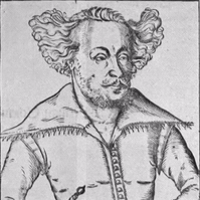Johann Hermann Schein (20.01.1586–19.11.1630)
Johann Hermann Schein was a composer and poet. He studied in Leipzig and held the position of St. Thomas cantor from 1616 to 1630.

1. Biography
Johann Hermann Schein was born on January 20th, 1586 in Grünhain near Annaberg (Saxony) as the son of Lutheran pastor and master Hieronymus Schein and his wife Judith. After the death of her husband in 1593 the widow moved with her children to Dresden. In 1599 Johann Hermann Schein was admitted to the Dresden Court Orchestra (Dresdner Hofkapelle) as a choir boy and was taught music theory and practice.
In 1603 he was enrolled early at Leipzig University holding a scholarship issued by the Elector of Saxony Christian II. He changed over to the Pforta Electoral Regional School (Kurfürstliche Landesschule Pforta) within the same year and stayed here until April 26th, 1607. After a short stay in Dresden from 1607 to 1608 Schein returned to Leipzig as a student. Even though studying jurisprudence he pursued his interests in poetry and music and started to compose while still being a student.
Starting in 1613 he worked as a private tutor and music director in Weissenfels for Gottfried von Wolffersdorff whom he had met at the Electoral Regional School. From 1615 on he worked as music director at the court in Weimar while composing simultaneously.
In April 1616 Schein became the St. Thomas cantor in Leipzig. He held this position until his death on November 19th, 1630.
2. Private Life
Johann Hermann Schein had to bear many misfortunes during his lifetime. He buried his first wife Sidonia Hösel, daughter of the Saxon elector’s treasure chamber secretary (Rentsekretarius) Eusebius Hösel, in 1624. She died after giving birth to their fifth child. Three children from this marriage died as infants. Only the two sons, Johann Samuel and Johann Hermann, outlived their father.
In 1625 Schein married his second wife, Elisabeth von der Perre in Leipzig. She gave him five more children, but four did not make through their first year. The fifth child was only baptized after the death of its father. During his term as St. Thomas cantor in Leipzig, Schein had been plagued by severe illness early on. During his final years he often travelled to Carlsbad (Karlovy Vary, Czech Republic) for treatment and hoped to be healed of gout, kidney stones and consumption. But he succumbed to consumption on November 19th, 1630 in Leipzig, shortly before his 45th birthday. His close friend and companion Heinrich Schütz dedicated his mourning-motet Das ist je gewisslich wahr (SWV 277) for six voices to the composer. Tobias Michael was appointed the next St. Thomas cantor.
3. Connection to Leipzig
Years of Study
In 1608 Johann Hermann Schein started to study in Leipzig with a scholarship from the Elector of Saxony. Here he studied the basics of liberal arts and then law until 1612. In the spring of 1609 the young composer published his first musical work, the Venus Kräntzlein. With his compositions Schein took part in the celebrations for the 200th anniversary of Leipzig University in December of 1609 and as a result was recognized by the music scene of Leipzig.
St. Thomas Cantor
On April 19th, 1616 Johann Hermann Schein was appointed St. Thomas cantor, succeeding the deceased Sethus Calvisius. Initially Schein described himself merely as “musicus” and cantor. But from 1622 on he was allowed to call himself “director musices”. His tasks as the St. Thomas cantor encompassed ten weekly lessons in humanities and four in music as well as being the music director of two of Leipzig’s churches, St. Thomas and St. Nicholas. Furthermore, he was responsible for the music at funerals and weddings as well as performances during public celebrations such as council elections.
Johann Hermann Schein was appreciated and very well liked in Leipzig. He cultivated friendships with the authorities, citizens and persons of rank. Starting in 1617 he published his musical anthologies annually at his own expense.
But Schein’s work as the St. Thomas cantor was also defined by the disputes with the director of St. Thomas school and the city council, which wasn’t necessarily his fault, but might have been due to the surrounding circumstances. The Thirty Years’ War started in 1618. The number of students decreased and teaching became more and more difficult. Nevertheless, Johann Hermann Schein was kept on as St. Thomas cantor until his death.
4. Reception
Schein’s musical and compositional work peaked during his time as St. Thomas cantor in Leipzig. During this period, he wrote the majority of his approximately 100 secular and 350 sacred compositions.
Johann Hermann Schein was not only one of the most significant German composers of the 17th century – as was his companion Heinrich Schütz – but he was also a poet. He wrote the lyrics for his secular songs himself. Schein was held in high regard amongst his contemporaries, not least for his achievements in the field of the “deutsche, geistliche Liede”1 (German sacred song). Unlike his secular compositions, his choral pieces, which were published in anthologies, were well known even at a later time.
1 Robert Eitner: “Schein, Johann Hermann”.
In: http://de.wikisource.org/wiki/ADB:Schein,_Johann_Hermann
5. Works
Sacred Music
Motet collections
1615: Cymbalum Sionium (published in Leipzig)
1623: Fontana d’Israel/Israels Brünnlein (published in Leipzig)
Sacred concerts
1618 and 1626: Opella Nova (1. part published in Leipzig, 2. part published in Freiberg)
Secular Works: Collections of Songs (Lieder)
1609: Das Venus Kräntzlein (published in Wittenberg)
1621, 1626, 1628: Musica boscareccia/Waldliederlein (3 parts, all published in Leipzig)
1624: Diletti pastorali/ Hirtenlieder (published in Leipzig)
1626: Studentenschmauss (published in Leipzig)
Instrumental Music
1617: Banchetto musicale (published in Leipzig)
The composer published all of his work at his own expense.
Instrumental Work
1617: Banchetto musicale (Published in Leipzig)
The complete works of the composer were self-published.
Audio Samples
Banchetto Musicale (1617) https://www.youtube.com/watch?v=gXVqDaJpLZA
Israelis Brünnlein (1623) https://www.youtube.com/watch?v=oFVdRgmbnho
6. Sources and Links
Finscher, Ludwig (ed.): Die Musik in Geschichte und Gegenwart, Personenteil, 2nd revised edition, Kassel a. o. 2003.
Prüfer, Arthur: Johann Hermann Schein. Habilitationsschrift, reprint of the original edition of 1895, Kassel 1989.
Seedorf, Thomas: Schein, Johan(n) Herman(n), in: Weber, Horst (ed.): Komponisten-Lexikon, 2nd edition, Stuttgart, Metzler & Bärenreiter 2003.
Eitner, Robert: Schein, Johann Hermann, http://de.wikisource.org/wiki/ADB:Schein,_Johann_Hermann.
Johann Hermann Schein (1586-1630) – Liebesgedichte, http://www.deutsche-liebeslyrik.de/schein_johann.htm.
Photo




